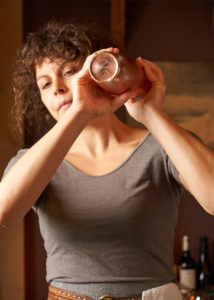How do you pour Maine in a glass?
November 2019
By Sofia Voltin
 Nikaline Iocono, owner of Vessel & Vine, has just launched her 2019 mixology university this year—to rave reviews. The kickoff class was “Wild-Crafted Cocktails,” where lucky students learned to make infusions, syrups, and tinctures with stimulating ingredients foraged from the Maine woods.
Nikaline Iocono, owner of Vessel & Vine, has just launched her 2019 mixology university this year—to rave reviews. The kickoff class was “Wild-Crafted Cocktails,” where lucky students learned to make infusions, syrups, and tinctures with stimulating ingredients foraged from the Maine woods.
She leans over her vintage-style bar. A dark curl falls over her forehead. “There are two schools of thought. One is that cocktails should deliver mystique.” A quick smile. “I’m from the other school. Cocktails should never intimidate. It’s ok to experiment and play with them on your own.
“Mixing cocktails is all about a few simple basic principles. Once you understand them, you earn the freedom to riff on classic cocktails and make something new. This is what people look to me for—a unique twist.”
Many of her students develop a signature style here. Vessel & Vine is half bar, half retail store. Her shop is stocked with elegant cordial glasses, vintage silver-plated corkscrews, copper-plated shaking tins, a cork and wood-grain ice bucket, a brass swan, etched floral coupes, wine, craft beer, rosé in a can, and essential ingredients. As in 30 to 40 types of amaro and vermouth. “You might taste something you love in these classes, and then you can buy it in the retail side of the store.” With newly gained knowledge and exotic ingredients, “people get really excited to go home and play.”
“The most frequent question I get is when to shake or stir, and for how long. Stir when it’s a spirits-only concoction, like a martini, manhattan or negroni. Shake when you’re adding juices or syrups, such as daiquiris and margaritas. As for how long—the goal is the appropriate level of dilution while thoroughly chilling the drink. As a guide, three ounces of spirits should dilute to four ounces.”
Students leave inspired and energized, but the classes offer further rewards, too. “They’re empowering—it sounds cheesy. The sweetest thing happens sometimes—people will create a new drink in class, write down the recipe, and then slip into the bar and ask me to make it for them. Moments like these capture what my classes are all about.”
“Always refrigerate your vermouth and wine-based ingredients like amari. Seventy-five percent of people who come in don’t realize that. It’s super important because they’re very perishable. They have a longer shelf-life than table wine, but it’s just 1 to 4 weeks.”
—Nikaline Iocono
Vessel & Vine, 4 Pleasant Street, Brunswick. Cocktail Concoction Classes: $45.
History 101
Mat Garofalo is the manager and mastermind behind the classes at 50 Local. “We host these classes only in the off-season. I try to do one per month, and we’ve been offering them for a year and a half.”
Each of Garofalo’s classes has a specific theme. On November 24, it’s Prohibition. “I’m reading a couple of books—Imbibe! by David Wondrich and Last Call: The Rise and Fall of Prohibition by Daniel Okrent. I’m going to spice up a history lesson with drinking and making cocktails that were around before, during, and survived after Prohibition. It will be much more hands-on, and less scientific, than the spirit-based classes because this will be solely about cocktails. Participants will make two different drinks while we talk cocktail backstories.”
Garofalo’a first outing this fall was “World of Whisk(e)y.” “The first hour was tasting different whiskeys—Scotch and Irish, bourbon and rye. In the second, everyone chose a cocktail to make showcasing whiskey.”
Mark Quinn of Kennebunk and Bedford, Massachusetts, warmed to this class with his wife, Debbie. “Learning about the diversity of bourbons, ryes, and other whiskeys from the perspective of the grains and mash used, how they’re distilled and aged, was the highlight of the night,” he says.
“It doesn’t get too wild here, but everyone has a good time,” Garofalo says. “People always end up enjoying the drinks, learning about the spirits. No one has ended up dancing on the bar—yet.”
50 Local, 50 Main Street, Kennebunk. Cocktail Classes: $55.
Temperance Studies
“We started out as a mocktail bar in July 2013, and we’ve been offering classes for about three years,” says Mary Jo Marquis of Vena’s Fizz House. “Winter is a great time for these classes, as people are looking for something fun to get out and do. We enjoy introducing new ideas and taking the intimidation out of making things yourself. We also like to talk about the history of the drinks—especially Portland history. After all, Portland is basically the home of the Prohibition movement.”
Vena’s Fizz House is named after co-owner Johanna Johnson Corman’s great-grandmother Irvina Johnson, or “Vena” for short. “She was president of the Maine Women’s Christian Temperance Union, so she was anti-alcohol and attached at the hip to Neal Dow,” Marquis says. “Two years after Vena’s opened, we added liquor to our menu. [The real] Vena would probably be spinning in her grave to know her great-granddaughter is serving alcohol. But cocktails and mocktails are still created equal here.”
What’s the top recurring question in the classes? “What is bitters, and what does it do for a drink,” says Steve Corman, self-proclaimed Bitterest Man in the World. “People use herbs and spices to enhance and flavor food—we use bitters in the same way. And a lot of people don’t know there are health benefits to bitters, too—come to a workshop, and you’ll learn more than you ever thought possible about bitters.”
“Mixology is an art form,” Marquis says. “You’ve learned a craft. Once you catch the bug it’s hard to stop.”
Vena’s Fizz House, 345 Fore Street, Portland. Mixology 101: $75; Let’s Make Mocktails!: $45; Fizzology 101: (Kids 8–12 years old) $20.






0 Comments